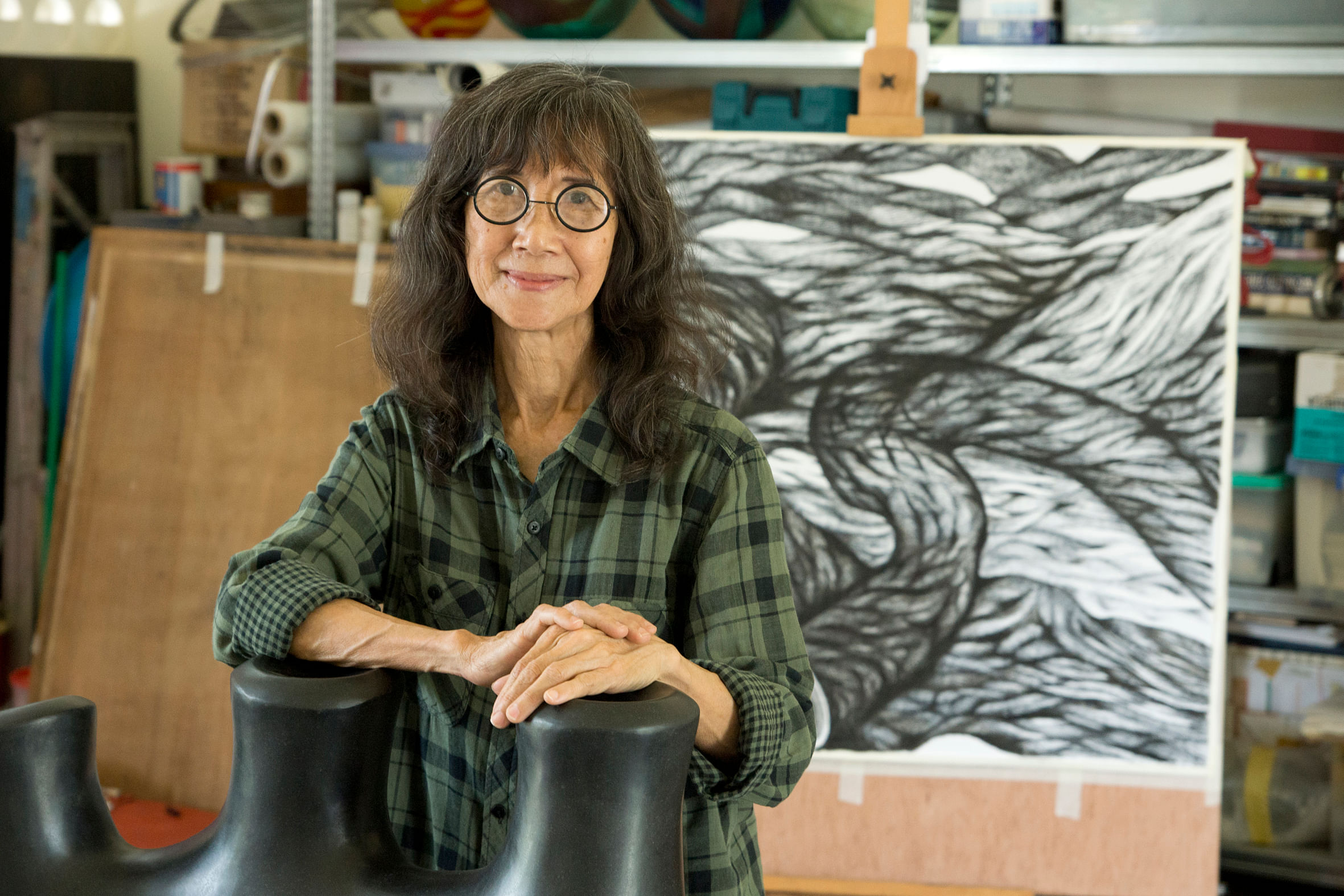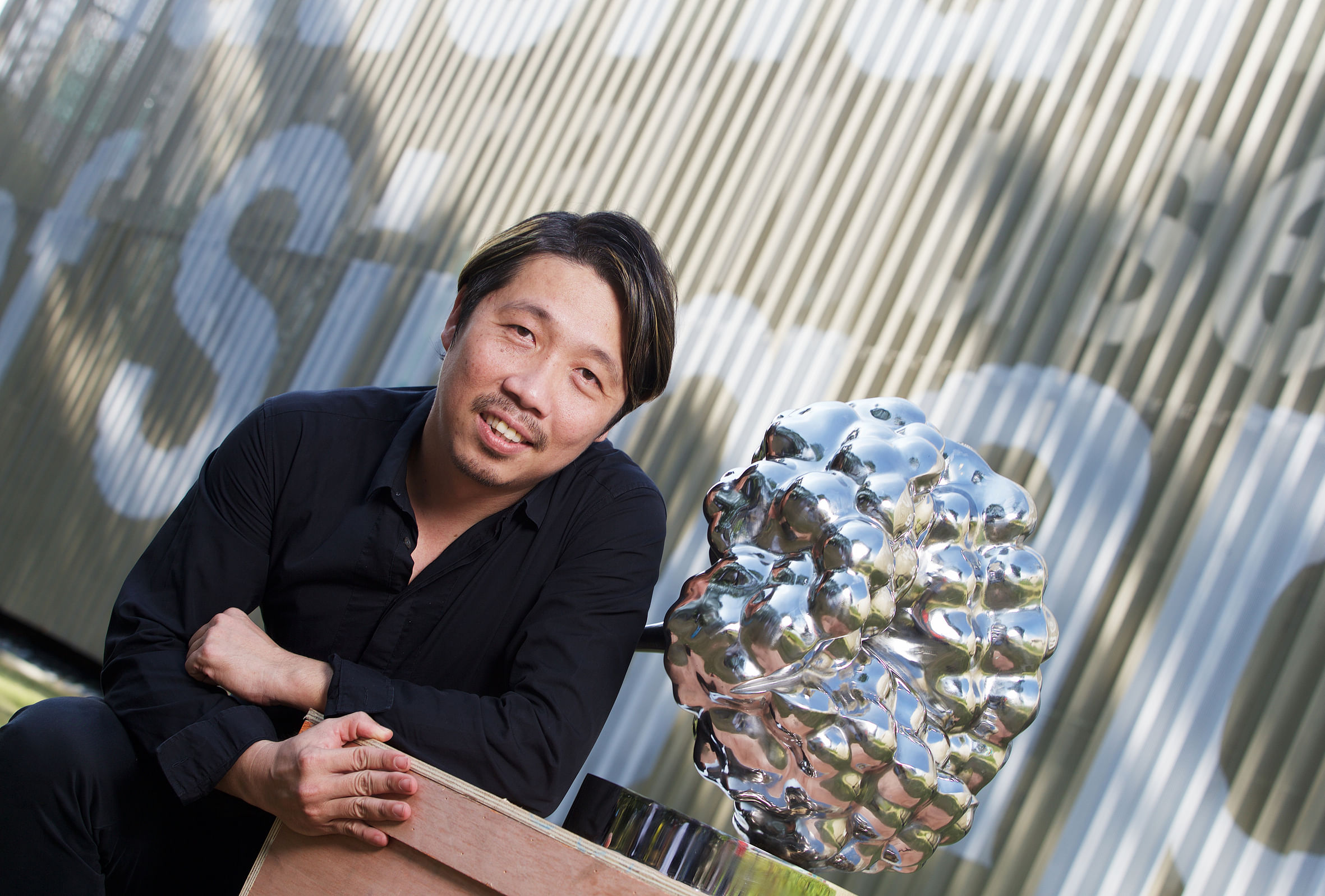To commemorate Singapore's Golden Jubilee, new sculptures have been commissioned for several public spaces.
At the Esplanade concourse, Han Sai Por's installation Harvest fills the space with a sea of birds, fish and fruit as the Cultural Medallion recipient celebrates the harmony of nature in all its forms.
Over at the Fort Canning entrance to the National Museum of Singapore, award-winning Singapore artist Yeo Chee Kiong's public sculpture In The Eye Of The Red Dot cuts a striking presence. Made of stainless steel, it resembles a blossoming flower, which symbolises the nation's achievements over the last 50 years.
Finally, American sculptor and artist James Surls' Fifty Wings, a 3m-tall sculpture of a cluster of floral forms, has been unveiled at the Singapore Botanic Gardens.
Art industry insiders say the Government's initiatives to support public art commissions this year have been a "significant impetus" for the creation of these new works.
For instance, under the Public Art Trust, corporate and individual patrons of the arts get a 300 per cent tax rebate on the cost of commissioning, installing and maintaining the works. An initiative by the National Arts Council, this aims to to make art a part of urban spaces. The Trust was established by the council last year with $10 million seed funding from the Ministry of Culture, Community and Youth.
Non-profit arts organisation Platform Projects is behind Surls' sculpture. Its director Shareen Khattar, 44, tells Life: "Patrons are drawn to sculpture because Singapore, with its juxtaposition of cutting-edge architecture with heritage buildings and lush green parks, offers many iconic spaces amid its urban and garden landscapes to present public art."
The Surls sculpture was made possible by a donation from a shipping magnate and his wife, while property developer City Developments Limited is behind Yeo's work at the National Museum.
Platform Projects, set up in 2012 to promote edgy and experimental projects, has also worked on other commissioned sculptures in the Gillman Barracks art cluster, to be unveiled next month, and in the heritage enclave of Joo Chiat.
Ms Christine Pillsbury, 41, one of Platform Projects' directors, says public sculpture is a form of long-term outreach for patrons: "The inherent durability of outdoor sculpture means it has a lasting impact of enriching public spaces for many years to come."
Sculptural installations also offer many possibilities for their creators and viewers, says Esplanade's head of visual arts, Ms Tamares Goh, 40.
"The beauty of still sculptures lies in the fact that they can be viewed and appreciated from different angles, giving us a different view each time," she says.
HARVEST BY HAN SAI POR
A dramatic mixed-media artwork takes pride of place in the Esplanade concourse.
Made primarily of stainless steel and stainless steel wire mesh, Harvest, by award-winning Singapore sculptor Han Sai Por, is a sprawling sculptural installation comprising 200 birds, 500 fish as well as other fruit and plant forms existing harmoniously together.
The arts centre approached the artist about a year ago to create a special work.
Han tells Life that "conceptualising the work was a little challenging because there is a lot going on at the Concourse, where the work is situated". Performances are held every evening in this area, the open space between the Esplanade Concert Hall and Theatre fronting the main entrance to the centre.

Her concept was to create a monochromatic installation. "I chose silver because it gives off a subtle sheen, yet it stands out from the surroundings."
The artist, who has created works for the Esplanade before, wanted her new sculpture to take on a lighter and more celebratory note. In 2011, she had presented paintings of scorched trees and razed forests which were displayed alongside a carpet of charcoal at the centre's Jendela visual arts space.
Her latest work is a lot more joyous.
The idea, the artist says, was to gather a fruitful harvest to mark Singapore's Golden Jubilee and the beginning of the next 50 years to come.
In the use of material, this is a departure from her signature stone sculptures that exude a feeling of intensity. Her work has long been centred around man's rapid destruction of the natural, indigenous environment. An example is her Seeds series of sculptures, installed permanently along the Esplanade waterfront.
Han, who is 72 and single, acknowledges that this new piece allows her to work with a different medium.
"Many people are familiar with my stone sculptures, but this time I wanted to do something different to convey how I feel. This is the first time I am using stainless steel as a raw material and I feel it is very suitable for the work because it has the ability to appear soft on the outside, yet it has great resilience."
While the title Harvest sounds like a celebration of material achievements, she stresses that the work is primarily "about our environment. For us to have a positive future, we must take care of the environment so it is comfortable and safe for everyone. If our environment is polluted, there is not much hope for our future".
Ms Tamares Goh, 40, head of visual arts at the Esplanade, says it commissioned Han because it wanted to "find aspects of Singapore, its environment, the community and its past and present".
She hopes Harvest and Seeds will call for reflection on the past and the future.
And if you like interactivity in art, do not leave the Esplanade without giving Singapore artist Lee Wen's popular doughnut-shaped ping pong table a shot. This interactive piece, titled Ping Pong Go-Round, has been to Hong Kong and Istanbul and is now at the centre's revamped Forecourt Garden, allowing viewers to pick up the paddle and play a game or two.
IN THE EYE OF THE RED DOT BY YEO CHEE KIONG
Next week, look out for a new sculpture at the National Museum of Singapore's Fort Canning entrance.
Award-winning sculptor Yeo Chee Kiong's In The Eye Of The Red Dot finds a space next to the unmissable large red pepper, Pedas-Pedas by Kumari Nahappan.
Yeo's work was picked from an open call that received 48 submissions. The commissioning partners for the piece are real estate developer City Developments Limited (CDL) and the museum.
Made of stainless steel, the sculpture resembles a blossoming flower meant to symbolise Singapore's achievements over the past 50 years.
The artist tells Life it "represents the unique and forward-looking vision of our country".

Once it is up, look out for the day-to-night transformation of the piece, a nod to how different the island looks at both times. In the day, you will see the silvery effect of stainless steel. At night, a red beam which will light up the piece will bounce off it, showing dramatic patterns on the metal surface.
Work on the piece has taken Yeo a "a very intense three months". During this production period, he has been pulling in 16-hour days, seven days a week, to get it finished on time.
The "eye" in the title refers to the kaleidoscopic triangle in the middle of the flower that will create fascinating and infinite refractions with the play of light, and it will look different during the day and night.
In 2008, Yeo, 45, won one the biggest art prizes in South-east Asia. His piece, A Day Without A Tree, a strong comment on global warming, won the inaugural Asia-Pacific Breweries Foundation Signature Art Prize.
His new piece is strongly rooted in Singapore's past and future possibilities.
National Museum director Angelita Teo says: "There is no better way to begin a journey exploring Singapore's history and culture in the museum than by thinking about how far we have come and what the future holds. I am glad the artwork makes use of our stunning location surrounded by Fort Canning and across the bustling city to create this platform for reflection."
As a developer and building owner, CDL has been incorporating sculptural art in many of its spaces and the support for this work is an extension of that. Since the 1990s, it has commissioned numerous local and international artworks for commercial and residential developments. For instance, the St Regis Singapore has more than 80 original artworks, including pieces by international masters such as Pablo Picasso and Fernando Botero and key Singapore artists such as Georgette Chen and Cheong Soo Pieng.
It has also supported local artists through the biennial CDL Singapore Sculpture Award, which was first held in 2003. Yeo won this award in 2005.
On CDL's support, Ms Esther An, chief sustainability officer of the group, says: "Sculptural art, given its strong presence, is able to connect people to spaces visually and emotionally."
FIFTY WINGS BY JAMES SURLS
A bronze-and-stainless-steel work is the newest addition to the outdoor sculptures dotting the Singapore Botanic Gardens.
The 3m-high sculpture by acclaimed American artist and sculptor James Surls, titled Fifty Wings, was commissioned for SG50 and made possible by a donation by Dr Helmut Sohmen, chairman of shipping company BW Group, and his wife Anna.
In a telephone interview with Life, Surls, who has a home in the Rocky Mountains in Colorado, says his art is inspired by nature and natural settings.
Fifty Wings is no different. It draws its artistic inspiration from the dipterocarp seed. Dipterocarps are among the tallest trees in the rainforest and can be found at the Botanic Gardens. The piece has been installed at a major artery of the Gardens, opposite the National Orchid Garden and next to the Giant Cola heritage tree.
The public art commission is the result of a collaboration between Singapore's Platform Projects, National Parks Board and BW Group.

The sculpture's 50 wings "represent each year of achievement. It is like Singapore - not only inherently strong, but also natural, green and dynamic in spirit", says the 72-year-old artist.
"I grew up fulfilling my creative thoughts in a natural garden. Now, I have the opportunity to fulfil my creative dreams in one of the world's great gardens," he adds.
The artist, whose work is in the permanent collections of established museums such as the Guggenheim and the Smithsonian, strongly feels that for any artwork, "looking good is not enough... there must be more".
So, Fifty Wings is represented by 10 dipterocarp seedpods, five on each side of the sculpture. Each seedpod has five wings, so there are a total of 50, one for each year of the country.
He says: "Singapore is a young country that took the creative lead and brought about a new way of making order from chaos. My sculpture celebrating this whirl in social history is seated in the gardens that are in the city within a country."
He visited Singapore for the first time more than 11/2 years ago and had been working on this piece since then.
He calls it a great honour to be selected for the commission. "My goal is to have my art in iconic gardens around the world."


